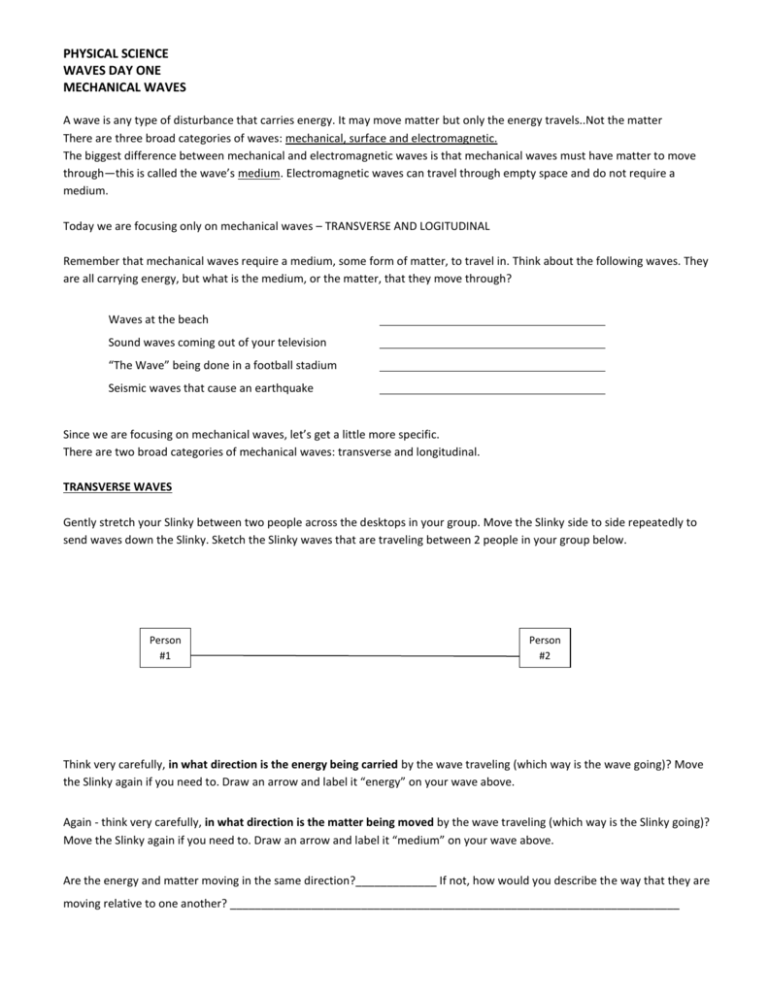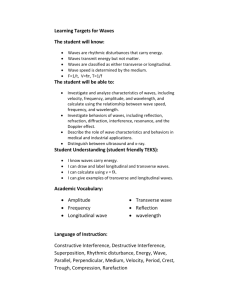PHYSICAL SCIENCE WAVES DAY ONE MECHANICAL WAVES A
advertisement

PHYSICAL SCIENCE WAVES DAY ONE MECHANICAL WAVES A wave is any type of disturbance that carries energy. It may move matter but only the energy travels..Not the matter There are three broad categories of waves: mechanical, surface and electromagnetic. The biggest difference between mechanical and electromagnetic waves is that mechanical waves must have matter to move through—this is called the wave’s medium. Electromagnetic waves can travel through empty space and do not require a medium. Today we are focusing only on mechanical waves – TRANSVERSE AND LOGITUDINAL Remember that mechanical waves require a medium, some form of matter, to travel in. Think about the following waves. They are all carrying energy, but what is the medium, or the matter, that they move through? Waves at the beach Sound waves coming out of your television “The Wave” being done in a football stadium Seismic waves that cause an earthquake Since we are focusing on mechanical waves, let’s get a little more specific. There are two broad categories of mechanical waves: transverse and longitudinal. TRANSVERSE WAVES Gently stretch your Slinky between two people across the desktops in your group. Move the Slinky side to side repeatedly to send waves down the Slinky. Sketch the Slinky waves that are traveling between 2 people in your group below. Person #1 Person #2 Think very carefully, in what direction is the energy being carried by the wave traveling (which way is the wave going)? Move the Slinky again if you need to. Draw an arrow and label it “energy” on your wave above. Again - think very carefully, in what direction is the matter being moved by the wave traveling (which way is the Slinky going)? Move the Slinky again if you need to. Draw an arrow and label it “medium” on your wave above. Are the energy and matter moving in the same direction?_____________ If not, how would you describe the way that they are moving relative to one another? ________________________________________________________________________ Complete the statement. In a transverse wave, the energy carried by the wave, and the medium through which the wave is traveling always move ______________________________________ to each other. LONGITUDINAL WAVES Gently stretch the Slinky again between two people in your group with the slinky on the floor or the desk. This time, have one of the people push the Slinky back and forth toward the other person. You are now creating a longitudinal wave. Sketch the Slinky waves traveling between those two people below. Person #1 Person #2 Think very carefully, in what direction is the energy being carried by the wave traveling (which way is the wave going)? Move the Slinky again if you need to. Draw an arrow and label it “energy” on your wave above. Think very carefully, in what direction is the matter being moved by the wave traveling (which way is the Slinky going)? Move the Slinky again if you need to. Draw an arrow and label it “medium” on your wave above. Are the energy and matter moving in the same direction?_____________ If not, how would you describe the way that they are moving relative to one another? ________________________________________________________________________ Complete the statement. In a longitudinal wave, the energy carried by the wave and the medium through which the wave is traveling always move ______________________________________ to each other. With both your transverse and longitudinal waves, they did something when they reached the opposite end. Explain what you see you waves do when they “hit” the other end. We’ll be talking about three things waves can do when they encounter a different medium (when they “hit” something) – they can: 1) Reflect – _________________________________________________________ a. Examples: 2) Refract - __________________________________________________________ a. Examples: 3) Diffract - __________________________________________________________ a. Examples: You have learned some about transverse waves in class. Using your knowledge, and the terms & definitions given below, label the following transverse wave AND write the correct term next to its definition. * amplitude * crest * resting point * trough * wavelength Fill in the blanks using the terms above: _____________________________________: the highest point on a transverse wave _____________________________________: the height of a wave; the distance from resting point to crest or from the resting point to the trough _____________________________________: the length of the wave; the distance from one point on the wave to the next identical point (ex: crest to the next crest) _____________________________________: the line that marks where the medium would be resting if a wave were not passing through it _____________________________________: the lowest point on a transverse wave Below is a figure of a longitudinal wave. Using the terms & definitions given below, label the longitudinal wave AND write the correct term next to its definition. * compression * rarefaction *wavelength Fill in the blanks using the terms above. : the crowded, bunched up area on a longitudinal wave—this corresponds to the crest of a transverse wave : the spread out/stretched out area on a longitudinal wave—this corresponds to the trough of a transverse wave : the length of the wave; the distance from one point on the wave to the next identical point (ex: beginning of a compression to the next beginning of a compression) Frequency is a term that is used to describe the number of wavelengths that pass a point in one second (f=# waves/second). The unit of frequency is Hertz (Hz). Move your Slinky side to side, again making transverse waves. Move it so that several waves are being sent in a set amount of time—you are sending waves at a high frequency. Now move it so that only a few waves are sent during a set amount of time— you are sending waves at a low frequency. What happens to the wavelength when you move the Slinky with a high frequency? ____________________________________ What happens to the wavelength when you move the Slinky with a low frequency? ____________________________________ Think about the relationship that you’ve just seen between wavelength and frequency. Complete the following statement. There is a(n) _____________________ relationship between frequency and wavelength, because as frequency ___________________ the wavelength _________________________. Do you think that the same relationship exists between frequency and wavelength for a longitudinal wave? Try it and see… What did you find out? Is the relationship the same? Both frequency and wavelength are used to determine the speed of a wave, using the formula: Vw = (f)(λ) (units are velocity – meters/second, or whatever distance/time you are using) In the formula, V w stands for wave velocity. Look at that formula – if Vw stays the same. What can you say about f and λ? As f increases, λ must _______________. For example, if Vw is 6 m/s and the frequency is 2, the wavelength of the wave must be ________. And if Vw stays the same at 6 m/s, but the frequency increases to 3, the wavelength must _____________ to _____. Try some: 1. What is the speed of a wave with a frequency of 5 Hz and a wavelength of 4 m? 2. What is the frequency of a wave with a speed of 40 m/s and a wavelength of 2 m? 3. What is the wavelength of a wave with a speed of 25 m/s and a frequency of 7 Hz? 4. A rope is shaken so that it has 10 waves passing a point in 8 seconds. If the waves are 50 cm from crest to crest, what is their speed?







